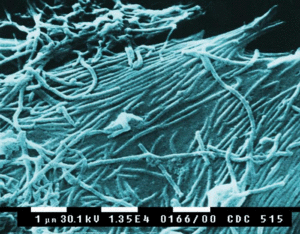Ebola Virus NEU2011: Difference between revisions
No edit summary |
No edit summary |
||
| Line 12: | Line 12: | ||
<u>Description and Significance </u>[[File:ebola img 2.gif|300px|thumb|right|SEM image of Ebola virus]] | <font size="4"><u>Description and Significance </u></font> <p align="top">[[File:ebola img 2.gif|300px|thumb|right|SEM image of Ebola virus]] | ||
The viral family Filoviridae consists of two distinct genuses, Marburgvirus and Ebolavirus. The family name describes the threadlike structure of the organisms that was identified by electron micrograph. Filoviruses are negative-strand RNA viruses, usually between 850 and 920nm in length [1]. In the Ebolavirus genus, four distinct species have been identified, three of which co-circulate in Africa, and are known human pathogens[2]. </p> | |||
<p>The Ebola virus (EBOV) strains were first identified in Africa in 1976. Two epidemics occurred almost simultaneously in Zaire and Sudan, killing almost 500 people. In Zaire, an outbreak at a local hospital, possibly due to contaminated hypodermic needles, yielded an 88% mortality rate. The predominant symptoms of the virus was hemorrhagic fever and damage to the endothelial cells that form the linings of blood vessels, characterized by severe internal and sometimes external bleeding. The responsible strain was identified and named Ebola, after the Ebola River region where the epidemic occurred. This strain of the virus is referred to as the Zaire virus, and is the type species for the genus [3, 4]. </p> | |||
<p> Since its discovery over 30 years ago, EBOV research has elucidated much about the mechanism by which an Ebola outbreak occurs. Since the epidemic in Zaire, several more cases have been observed in humans and animals, though no other strain has proved as deadly as that isolated from the Ebola River area [2]. While research has significantly expanded knowledge about how the virus survives between epidemics and how it is passed to human populations, much is still unknown about EBOV. With the modern advent of biological warfare, the contagiousness and lethality of EBOV makes it a potential weapon [5]. Therefore, further research is important to understand and hopefully identify a vaccine for EBOV, to protect against future epidemics.</p> | |||
Revision as of 20:02, 21 February 2011
Ebola Virus
Classification
Class: ssRNA negative-strand viruses
Order: Mononegavirales
family: Filoviridae
genus: Ebolavirus
species: Zaire ebolavirus
(based on Baltimore classification system)
Description and Significance
The viral family Filoviridae consists of two distinct genuses, Marburgvirus and Ebolavirus. The family name describes the threadlike structure of the organisms that was identified by electron micrograph. Filoviruses are negative-strand RNA viruses, usually between 850 and 920nm in length [1]. In the Ebolavirus genus, four distinct species have been identified, three of which co-circulate in Africa, and are known human pathogens[2].
The Ebola virus (EBOV) strains were first identified in Africa in 1976. Two epidemics occurred almost simultaneously in Zaire and Sudan, killing almost 500 people. In Zaire, an outbreak at a local hospital, possibly due to contaminated hypodermic needles, yielded an 88% mortality rate. The predominant symptoms of the virus was hemorrhagic fever and damage to the endothelial cells that form the linings of blood vessels, characterized by severe internal and sometimes external bleeding. The responsible strain was identified and named Ebola, after the Ebola River region where the epidemic occurred. This strain of the virus is referred to as the Zaire virus, and is the type species for the genus [3, 4].
Since its discovery over 30 years ago, EBOV research has elucidated much about the mechanism by which an Ebola outbreak occurs. Since the epidemic in Zaire, several more cases have been observed in humans and animals, though no other strain has proved as deadly as that isolated from the Ebola River area [2]. While research has significantly expanded knowledge about how the virus survives between epidemics and how it is passed to human populations, much is still unknown about EBOV. With the modern advent of biological warfare, the contagiousness and lethality of EBOV makes it a potential weapon [5]. Therefore, further research is important to understand and hopefully identify a vaccine for EBOV, to protect against future epidemics.

